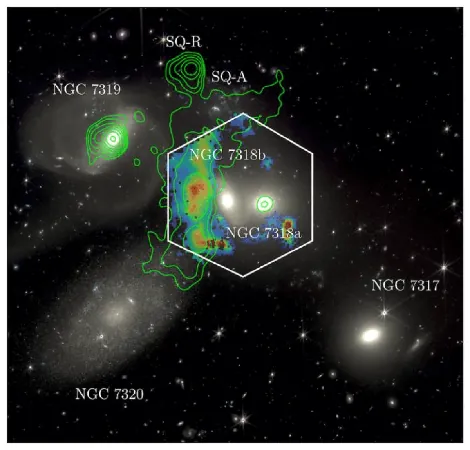
Astronomers Unveil Incredible Insights into Galaxy Collisions: The Secrets of Stephan's Quintet Revealed!
2024-12-07
Author: Siti
Exploring the Shock Front in Stephan's Quintet
Utilizing the state-of-the-art WEAVE-LIFU instrument mounted on the William Herschel Telescope, researchers performed an in-depth analysis of the shock front in Stephan's Quintet. This powerful tool enabled them to acquire high-resolution spatial and spectral data, essential for deciphering the dynamics of this cosmic collision.
By integrating both archival and newly collected multiwavelength data—spanning radio, optical, and infrared observations—the team painted a comprehensive picture of the interplay between gas and dust in this galactic arena. Advanced spectral fitting techniques, which utilized multiple Gaussian components, allowed scientists to delve deep into gas characteristics such as temperature, density, and motion. Methods like the Balmer decrement helped estimate dust extinction and electron density, leading to a clearer understanding of the shock environment.
Fascinating Findings Uncovered
One of the key findings of the study is that the shock front within Stephan’s Quintet measures approximately 45 kiloparsecs across, demonstrating complex interactions among various gas phases. Researchers discovered that while the shock is hypersonic in colder gases, it appears relatively weak in hotter plasma, impacting its capability to accelerate particles and generate synchrotron emissions effectively.
Further analysis revealed substantial emissions from warm molecular hydrogen, overshadowing X-ray emissions and indicating that the shocks are adept at dissipating energy through molecular processes. Notably, regions with high extinction correspond with active star formation, often leading to a clearing of dust and materials within the shock zones, unveiling turbulent energy exchanges across all gas phases.
Remaining Questions and Future Directions
Despite the advancements in spatial and spectral resolution through this study, challenges remain. The ability to isolate specific substructures within the shock region was limited, and researchers faced hurdles in accurately determining temperatures for hotter gases, partly due to missing emission line detections. This opens the door for future studies to further investigate the survival of dust grains and the formation mechanisms of molecular gas in shock environments, which are still areas of uncertainty.
This revelatory research emphasizes the intricate and dynamic processes at play in interacting galaxy groups such as Stephan’s Quintet. The implications of these findings suggest that shocks play a significant role in energy dissipation and could be crucial in influencing star formation and the broader evolution of galaxies.
The Road Ahead: High-Resolution Observations
With tools like the James Webb Space Telescope (JWST) on the horizon, the potential for high-resolution spectroscopic observations promises to refine these findings and provide answers to lingering questions about the behavior of gas and dust in extreme galactic environments. As astronomers continue to unveil the mysteries behind galaxy collisions, humanity’s understanding of cosmic evolution is set to deepen, paving the way for future explorations of our vast universe.
The research was supported by an extensive consortium of institutions, spearheaded by UKRI STFC and including esteemed partners like the University of Oxford and the Instituto de Astrofísica de Canarias. As scientists look to the stars, the insights gleaned from this study could hold the key to unlocking further secrets of the universe. Stay tuned as we continue to track these celestial developments!





 Brasil (PT)
Brasil (PT)
 Canada (EN)
Canada (EN)
 Chile (ES)
Chile (ES)
 España (ES)
España (ES)
 France (FR)
France (FR)
 Hong Kong (EN)
Hong Kong (EN)
 Italia (IT)
Italia (IT)
 日本 (JA)
日本 (JA)
 Magyarország (HU)
Magyarország (HU)
 Norge (NO)
Norge (NO)
 Polska (PL)
Polska (PL)
 Schweiz (DE)
Schweiz (DE)
 Singapore (EN)
Singapore (EN)
 Sverige (SV)
Sverige (SV)
 Suomi (FI)
Suomi (FI)
 Türkiye (TR)
Türkiye (TR)